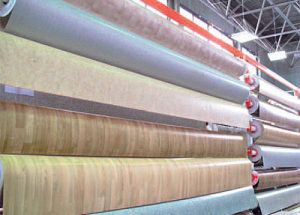Choosing the type of flooring in your house, we always meticulously ask questions: "How much will the coating service, is it simple in maintenance and how much does it cost?". Dense and flexible waterproof linoleum - linoleum, fully meets all necessary requirements. That's why we give linoleum preference.
Content
Existing types of linoleum
It has been almost a half century since the first samples of linoleum appeared. During this time, the floor covering was transformed from clumsy and bulky canvases into an original, strong roll. What is linoleum today? The composition of the binder material linoleum is divided into the following types:
• natural
• PVC
• nitrocellulose
• Rubber
• alkyd.

Natural linoleum
An honorary old-timer is considered to be a natural linoleum, which has the highest wear resistance and abrasion resistance, anti-static and resistance to aggressive media. With good care and comfortable "position" linoleum natural does not burn out, does not have an unpleasant synthetic smell, does not crumble and so for 20 years. Such an enviable patience and stability is based on the "inner content and condition" of linoleum. Non-woven materials and fibers are part of the natural coating:
• jute
• Linen
• hemp
• Coniferous resin
• natural dyes.
Naturally, the price of natural linoleum is appropriate.

The basis of linoleum
By the presence or absence of a foundation, the classification of linoleum is divided into linoleum on the basis of and baseless.
The non-basic type of coating has two or more layers. The thickness of linoleum of the basic reaches 3 mm, while its structure is homogeneous (homogeneous), therefore physical properties and performance are the same for all directions of deformation, compression or twisting. The value of this type of coating is that the texture and color do not change a significant amount of time. This allows you to use linoleum in rooms with intensive traffic and daily load: toilets, swimming pools, showers.

The non-basic type is characterized by a surface roughness, which in turn makes it possible to hide unevenness and defects in the floor.
Linoleum on a synthetic foam base (polyvinyl chloride) is a roll coating with an average degree of flexibility with a thickness of up to 3.5 mm. The technology of the foamed base provides ample opportunities for creating a linoleum with a variety of textured patterns and colors. This type of coating is used throughout the living rooms and rooms, regardless of the temperature and humidity regime.
Linoleum on a fabric or jute basis is a coating consisting of two layers. The bottom layer is a base 5 mm thick, the top layer is PVC. The main application of this type of coating is increased thermal insulation.

Commercial and semi-commercial types of linoleum
It should be recalled that the classification of PVC coatings is closely related to its wear resistance. From here appeared a fashionable and understandable name for all "commercial" linoleum. ABOUT! the great word "commercial" ... In what, after all, is your meaning and, excuse for curiosity, an appointment? Cutting, at the beginning, the ear of the phrase "business structure", "commercial enterprise" smoothly passed into the concept of "commercial linoleum." Do you catch the connection? Speaking of the available language, commercial linoleum is designed for rooms and rooms with a high intensity of passage.

There are two types of commercial linoleum:
• homogeneous
• heterogeneous.
They differ in the components of the internal structure. Linoleum homogeneous in cross section has a homogeneous structure, and the pattern must pass through the entire thickness of the cut. The appearance of the pattern of homogeneous linoleum is maintained during operation.

The semi-commercial linoleum occupies an average position between the commercial and household coverings. Being in the golden middle, the semi-commercial absorbed the best qualities:
• Increased durability
• Simplicity of laying
• ease of maintenance and operation.

Semi-commercial linoleum is a heterogeneous PVC coating. In the coating: substrate, fiberglass, protective layer and an improved decorative layer. The substrate can be a solid and porous structure, the thickness of the PVC layer too. This type of coating is most in demand in rooms with low load and is laid where there is no contact with the street. The main advantage of this type of coverage is a long service life, relative cost and ease of maintenance. Fits on a pre-prepared working base, which does not have dents, cracks or potholes. Cramming a new floor covering over the old is strictly not recommended.
Warm linoleum
Linoleum, made on a felt or jute basis, is considered insulated. This type of linoleum warm consists of two layers. The upper PVC layer gives the coating a durability and an aesthetic appearance. The lower layer - the substrate is made of soft materials, which keep the heat well. The thickness of this coating is 4 mm.

Designation of linoleum
Linoleum of domestic production from their counterparts in Europe are distinguished by the presence on the inside of the coating designation. Approximately here is the content: LP-T-OP; LP-NT-MP; LP-RC-OP, where:
• LP-T-OP is a polyvinylchloride linoleum that has a fabric base with a single-colored print
• LP-NT-MP linoleum PVC on non-woven basis with multi-color printing
• LP-RK-OP is a PVC linoleum based on artificial leather with a single-color print.

The thickness of the protective layer of any type of linoleum is regulated as follows:
for residential rooms (moderate patency), the thickness of the layer is 0.15 mm.
for rooms having an average patency, the thickness of the layer is 0.20 mm
for rooms with considerable patency the layer has a thickness of 0.25 mm.
The most popular and popular are the layer thickness 1.5; 3; 4 mm.
You decided to buy a linoleum and do not know how to choose the right one? Expert tips will tell you how to correctly select the coverage in the video.



















